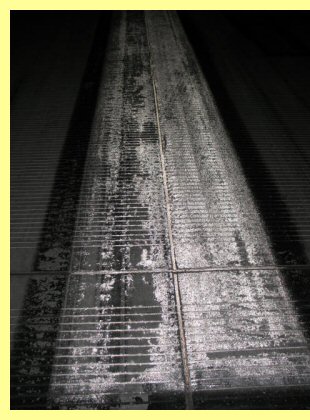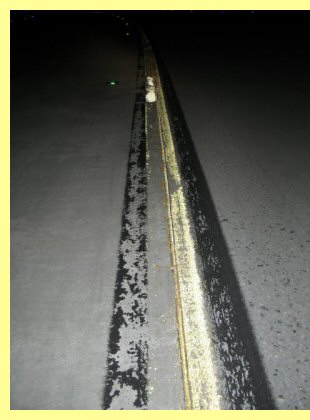
|

|
|
First In, Last Out: "FILO"By Donna SpeidelFILO is used as an accounting term to describe the flow of inventory; but is used here to describe the normal world of the pavement marking contractor. Enter the general contractor who was likely the low bidder on a runway paving or rehabilitation contract that needs to displace the runway threshold so work can begin on the displaced end. The striping subcontractor gets the call and is first on site to apply the markings. Once displaced, the other pieces of the project are assembled and the job is underway. Toward the end, after all the excavation, paving, electrical wiring, lights, signs, joint sealing, and grooving comes, again, the striping contractor; this time to install the permanent markings. The seeding contractor is also usually there, too; and is bound and determined to not only seed the dirt where grass will grow, but spray the edge of the pavement as well... not real conducive to markings to be painted. And generally the electrical contractor is still moving about the pavement installing the last minute lights and signs; and they don't like the waterblaster getting their area wet! Joint sealers might still be sealing and warning the striper not to paint until "tomorrow" to let the sealant set up properly. Among the remaining, harried subcontractors is the pavement marking sub, one of the last on the job doing whatever it takes to finish up; "Git er done" is becoming our mantra.
Therein is the dilemma. The striping contractor knows the chances of the paint performing well are slim when the weather is cool and damp. He produces a waiver form for the contractor to sign so that if the paint fails to adhere, he won't be held responsible for the one year warranty. The contractor resists signing, but finally agrees so the work can be done on schedule. The fact is, the project may get finished on time, but the quality of the markings applied may lead to issues the airport should not have to inherit.
Junk in, junk out. If the clock could be rolled back when the markings were being applied to the new runway surface, some other things could have been done that would have solved everyone's timetable, but may have required a little more money and some nighttime closures after the runway was opened. As it is, putting more paint and glass beads on an already poorly bonded surface is throwing good money after bad. The best solution now is to have the markings completely removed and then reapplied at the correct application rates... lots more money and time.
Isn't it time markings were considered another vital part of the Navaids system, rather than an
afterthought?
The pavement marking contractors will always be first in and last out. The key is to provide them with enough time and the right conditions; and to take the attitude that markings do matter; there are right ways to apply them, and a long list of wrong ones! |

 Everyone is under the gun and approaching the project deadline. There have been delays throughout the one to
two year project, but everything is now up to the marking contractor to get done on time. And the markings have to be done under
prevailing weather conditions, even though they were likely scheduled months earlier when the weather was drier and warmer.
"It's just paint," said the general contractor when the striper protested the conditions, "the jobs gotta get done! Paint it!"
Everyone is under the gun and approaching the project deadline. There have been delays throughout the one to
two year project, but everything is now up to the marking contractor to get done on time. And the markings have to be done under
prevailing weather conditions, even though they were likely scheduled months earlier when the weather was drier and warmer.
"It's just paint," said the general contractor when the striper protested the conditions, "the jobs gotta get done! Paint it!"
 A recent scenario: A runway has markings peeling off after only having been opened for a few months. When
the inspector is questioned, he admits the weather conditions were not the best; but there was a deadline, a ribbon cutting
ceremony was scheduled... a lot was on the line, so to speak. But now, the airport maintenance crew, responsible for maintaining
the markings, is facing a bigger problem: if they paint over the peeling markings, all they will get is fresh, peeling paint. If
they don't maintain the markings, they might get sited by the FAA inspector!
A recent scenario: A runway has markings peeling off after only having been opened for a few months. When
the inspector is questioned, he admits the weather conditions were not the best; but there was a deadline, a ribbon cutting
ceremony was scheduled... a lot was on the line, so to speak. But now, the airport maintenance crew, responsible for maintaining
the markings, is facing a bigger problem: if they paint over the peeling markings, all they will get is fresh, peeling paint. If
they don't maintain the markings, they might get sited by the FAA inspector!